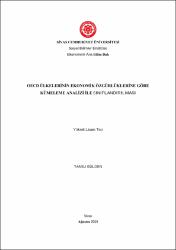Oecd Ülkelerinin Ekonomik Özgürlüklerine Göre Kümeleme Analizi İle Sınıflandırılması
Abstract
Ekonomik özgürlük, birey ya da firmaların ekonomik faaliyetlerde
bulunurken herhangi bir kısıtlama altında olmamasıdır. Bu çalışmanın amacı
Ekonomik Kalkınma ve İşbirliği Örgütü bünyesindeki ülkeleri ekonomik
özgürlüklerine göre kümelere ayırıp sınıflandırmaktır. Çalışmada Heritage Vakfı ve
Wall Street Journal tarafından her yıl yayınlanan Ekonomik Özgürlük Endeksi (IEF)
raporundan faydalanılmıştır. OECD ülkelerinin, IEF raporundan elde edilen 2015-
2019 dönemine ait verileri kullanılmıştır. Kümeleme analizi gruplanmamış verileri
benzerliklerine göre sınıflara ayırmakta kullanılan bir yöntemdir. Çalışmada önce
hiyerarşik kümeleme yöntemlerinden Ward yöntemi kullanılmıştır. Daha sonra
hiyerarşik olmayan kümeleme yöntemlerinden k-ortalamalar tekniği kullanılmıştır.
Çalışmanın sonuç bölümünde her yıl için analizler yapılarak sınıflandırılan ülkeler
değerlendirilmiştir. Economic freedom is the absence of any restrictions on the economic
activities of individuals of firms. The aim of this study is to differentiate and classify
the countries within the Organization of Economic Development and Cooperation
according to their economic freedoms. In this study, the Economic Freedom Index
(IEF) annually report by the Heritage Foundation and the Wall Street Journal was
used. Data of the OECD countries for the period 2015-2019 was obtained from the
IEF report and has been used accordingly. Clustering analysis is a method used to
classify ungrouped data into classes according to their similarities. First, the Ward
method was used for hierarchical clustering methods. The non-hierarchical clustering
methods k-averages were then used. In the conclusion part of the study, the countries
which are analyzed by making analyzes for each year are evaluated.















